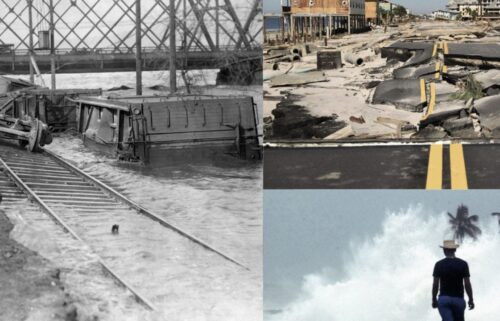The hidden cost of gasoline
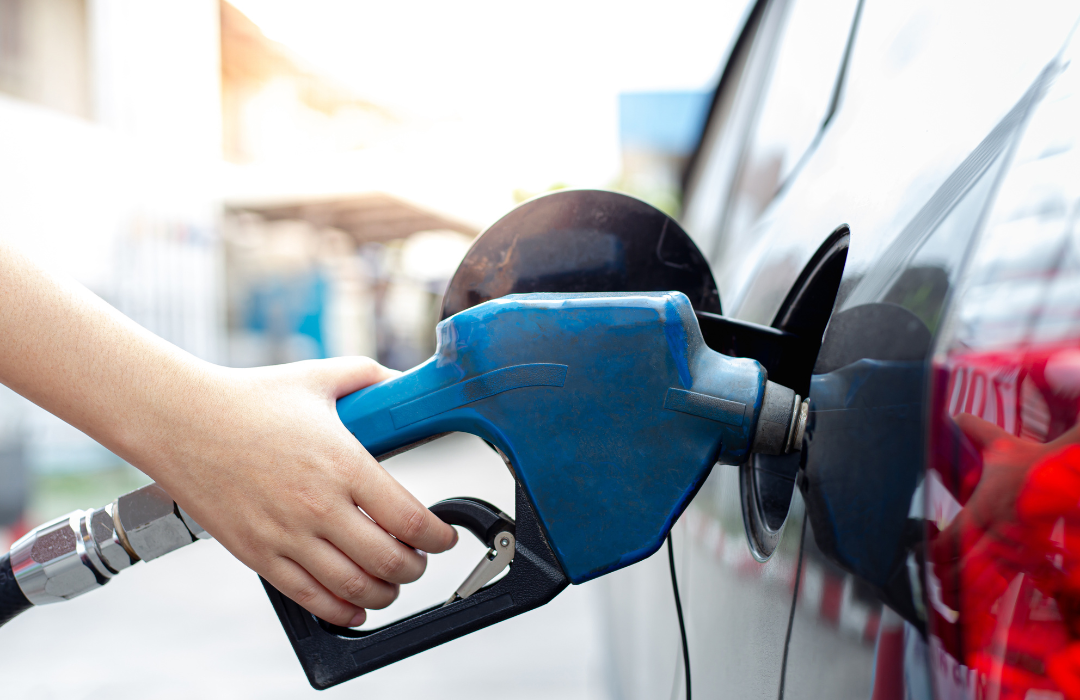
Canva
The hidden cost of gasoline
Person’s hand filling gas tank of car.
A black, electric-powered Nissan Leaf pulled up to a gas station — not to fuel up, of course. Matthew Metz, the founder of Coltura, a nonprofit trying to speed up the country’s shift away from gasoline, climbed out of his car with printed maps in hand, prepared to give me a tour.
It was a sunny spring day, and the Arco station in North Seattle looked like any other on a busy street corner, with cars fueling up and a line of bored people waiting to buy snacks and drinks inside the convenience store. Metz knows a lot about gas stations, and it changes what he sees. Looking around, he marveled at the risks that everyone was taking, even if they weren’t aware of it. “This is a hazardous materials facility,” he told me.
Drivers pumped their tanks with gas, breathing carcinogens like benzene, the source of gasoline’s signature sweet smell. On the east side of the property, tall white pipes that vent toxic vapors from petroleum kept underground stood just 10 feet away from the window of a childcare center. Hidden below the station is a tract of contaminated soil that extends underneath a neighboring apartment building.
The Arco station has a long history of leaking, with petroleum products discovered floating in the septic tank beneath it in 1990. After decades of efforts to remove and break down that pollution — a host of contaminants including lead, benzene, and the suspected carcinogen methyl tertiary-butyl ether — trace amounts remain, with some highly polluted patches in the soil. One sample taken late last year showed levels of gasoline-related compounds 72 times higher than Washington state’s allowable limit.
![]()
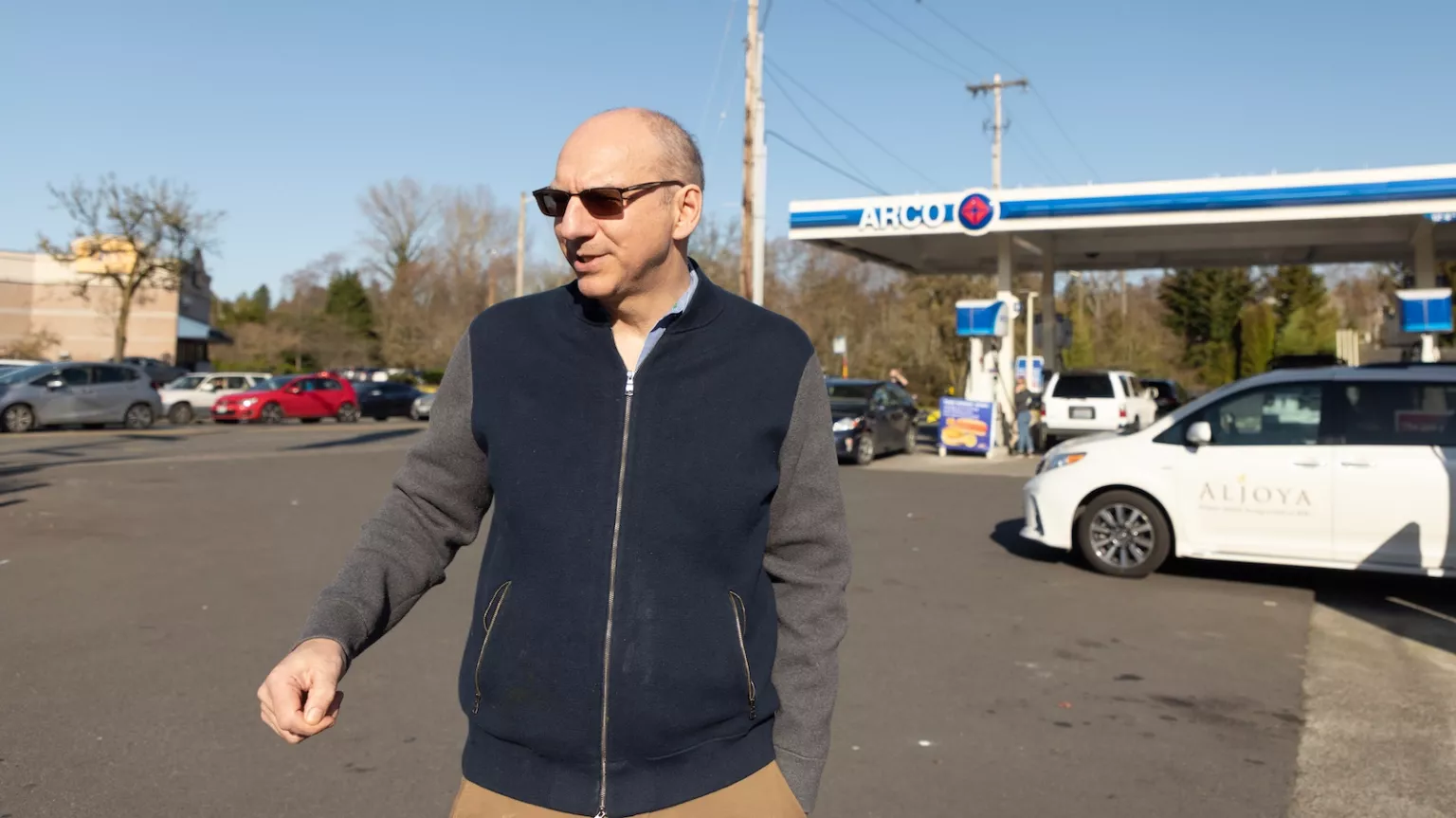
Portrait of Coltura founder Matthew Metz by Jesse Nichols // Grist
Groundwater pollution
Matthew Metz, founder of Coltura, walks in the paved area of a gas station.
This Arco station is hardly unique. Almost every gas station eventually pollutes the earth beneath it, experts told Grist. The main culprit: the underground storage tanks that hold tens of thousands of gallons of fuel, one of the most common sources of groundwater pollution. Typically, two or three of these giant, submarine-shaped tanks are buried under a station to store the gasoline and diesel that gets piped to the pump. A large tank might be 55 feet long and hold as many as 30,000 gallons; a typical tank might hold 10,000 gallons. Leaks can occur at any point — in the storage tank itself, in the gas pumps, and in the pipes that connect them. Hazardous chemicals can then spread rapidly through the soil, seeping into groundwater, lakes, or rivers. Even a dribble can pollute a wide area. Ten gallons of gasoline can contaminate 12 million gallons of groundwater — a significant risk, given that groundwater is the source of drinking water for nearly half of all Americans.
As a result, time-consuming cleanup efforts are unfolding all across the country, with remediation for a single gas station sometimes topping $1 million. Leaks are such a huge liability that they’ve led to a high-stakes game of hot potato, where no one wants to pay for the mess — not the gas station owners, not the insurance companies that provide coverage for tanks, not the oil companies that supply the fuel. In some states, polluters have shifted tens of millions of dollars in remediation costs onto taxpayers. Roughly 60,000 contaminated sites are still waiting to be cleaned up, according to the Environmental Protection Agency, or EPA — and those are just the ones that have been found. Washington state has about 2,500 in line, one of the biggest backlogs in the country.
Much of this pollution has been stagnant for decades. Forty years ago, steel storage tanks began corroding, setting off a slow-motion environmental disaster all over the United States. Leaks often weren’t discovered until long after petroleum had poisoned the groundwater, when neighbors of gas stations began complaining that the water from their taps smelled like gasoline. In 1983, the EPA declared leaking tanks a serious threat to groundwater, and Congress soon stepped in with new regulations. One of the largest spills was in Brooklyn, where a 17 million-gallon pool of oil gradually collected beneath a Mobil gas station — a larger spill than the Exxon Valdez disaster in 1989, when a tanker ran aground in Alaska and poured oil into Prince William Sound.
Fast-forward to today, and more than half a million leaks have been confirmed around the country. The Government Accountability Office estimated in 2007 that the total bill for cleanups would top $22 billion. Those old, decrepit storage tanks have left a legacy: overgrown, empty lots that real-estate developers don’t want to touch. Of the roughly 450,000 brownfields in the country, nearly half are contaminated by petroleum, much of it coming from old gas stations.
As the contamination from these spills lingers, underground storage tanks are becoming a problem again as the next generation of tanks — installed in a rush after the old steel ones started breaking — begin nearing the end of their 30-year warranties, when there’s broad consensus they are highly likely to leak. In Washington state, for instance, the average tank is about 29 years old. The tanks at the Arco station in North Seattle were replaced in 1990, soon after contamination was discovered, putting them a few years past the 30-year cutoff.
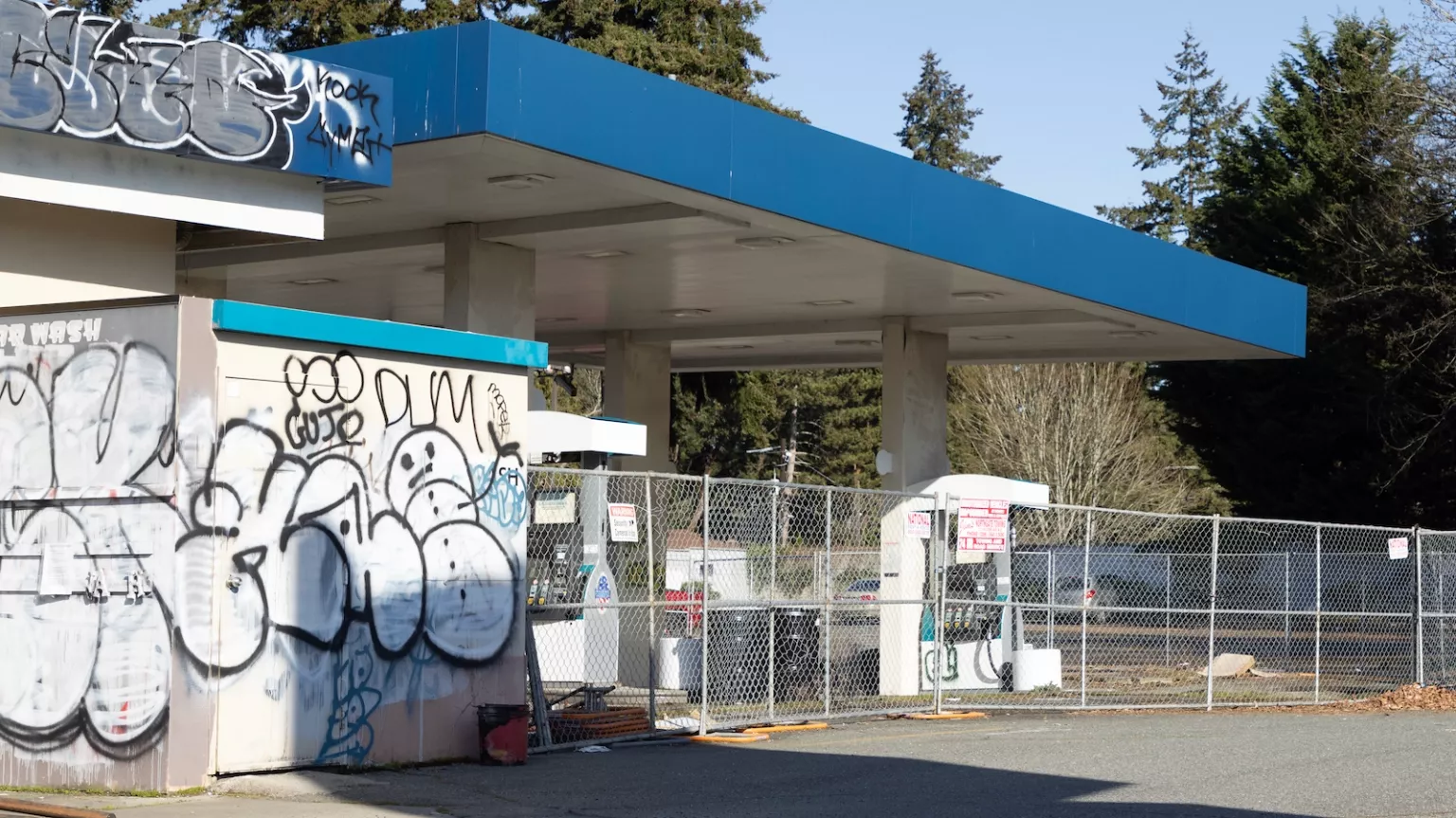
Jesse Nichols // Grist
Federal regulations
A gas station is surrounded by wire fencing and has graffiti on its walls.
Congress passed a series of amendments to the Resources Conservation and Recovery Act in the 1980s introducing federal regulations to find and prevent spills. The law mandated that owners of underground storage tanks demonstrate they can cover $1 million in damages from contamination, a requirement often met by buying insurance from private companies and special state cleanup funds. States are responsible for implementing the regulations, and take different approaches to enforcement, cleanup, and insurance.
But states are discovering that many private insurers, which have long hesitated to provide coverage, are even more reluctant as tanks get older. “I don’t think they’re super thrilled to insure them anymore,” said Cassandra Garcia, the deputy director of Washington state’s Pollution Liability Insurance Agency. “This isn’t generally the most profitable business line for them.”
If gas stations don’t have insurance, states can shut them down. This predicament prompted Washington state to adopt a new law this spring providing fully state-backed insurance for gas stations. But critics like Metz wonder whether stations need to be saved at all. With electric vehicles on the rise, Metz thinks that selling gasoline is a dying business. “The whole financial underpinnings of gas stations are starting to crumble,” Metz said.
Gas stations often bear the names of major oil companies such as ExxonMobil, Shell, and Chevron, but that doesn’t mean those companies actually own the stations. Usually, they supply the fuel to independent business owners who signed agreements to sell their products and pay royalties to use their branding. Back in the day, oil companies owned a lot of stations (and thus the tanks beneath them); today, the top five largest oil companies own about 1 percent of gas stations.
The number of stations overall has been in decline for decades thanks to mediocre profits, rising land values in cities, and more fuel-efficient cars. An analysis from Boston Consulting Group found that between 25 and 80 percent of gas stations nationwide could be unprofitable in 12 years — and that analysis was conducted in 2019, before a slate of new policies, including federal tax credits, were passed to promote electric vehicles. Under vehicle-emissions rules unveiled by the Biden administration in April, EVs would make up as much as two-thirds of all U.S. car sales by 2031. Last year, Washington state set a target of ending the sale of new gas-powered vehicles by 2030, just seven years away; it has also adopted California’s stricter deadline of 2035, along with five other states.
That shift could lead to a pileup of vacant gas stations that the existing cleanup programs won’t be able to handle. There are more than 145,000 fueling stations in the U.S., according to the National Association of Convenience Stores. Even if the country manages to break off its century-long attachment to gasoline, the fuel’s legacy may live on in the soil and water. The question of who pays to clean up the contamination is a mess in itself: In theory, station owners are supposed to pick up the tab, but sometimes they’re unable to pay — or unable to be found — when the bill comes due. So then, who pays? Sometimes it’s an insurance company, sometimes it’s an oil company, and sometimes it’s the government. It’s up to lawyers and courts to hash it out.
“This is a huge problem nationally,” Metz said. “It’s all over the country. There are all these abandoned gas stations, and it’s just going to get worse.”
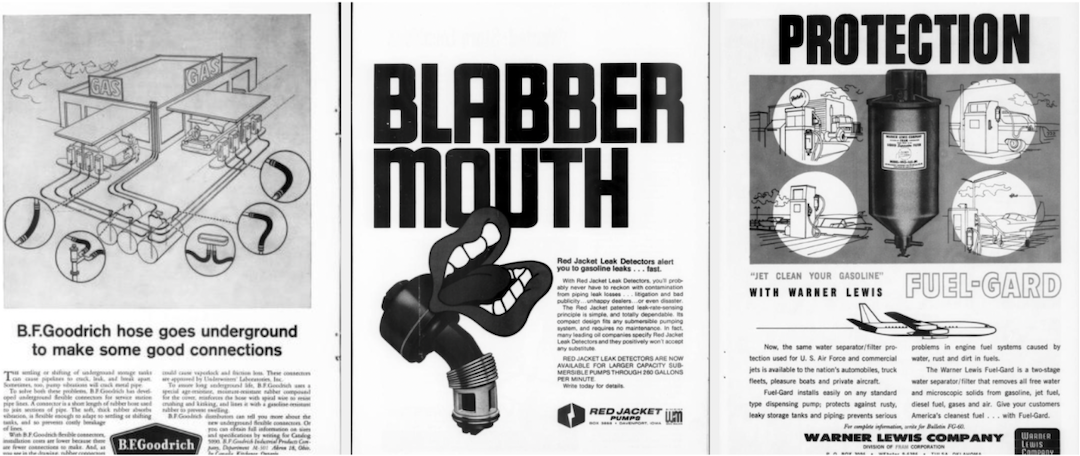
National Petroleum News Archive
Environmental disasters
Black-and-white magazine advertisements about the potential for underground tank leaks.
Behind just about every environmental program in the United States is an environmental disaster that brought it into being, and leaking gas stations are no exception. In this case, the disaster became public in December 1983, when a 60 Minutes segment warned Americans that underground storage tanks were a “time bomb” in their neighborhoods. The show documented the daily struggles of families in a small Rhode Island town whose drinking water had long been contaminated by Mobil and Exxon stations uphill. With 2 or 3 of every 10 gas stations in the country leaking, the show’s host, Harry Reasoner, told viewers that it promised to be the pollution disaster of the 1980s.
The catastrophe was set in motion in the years after World War II, when many Americans bought cars and moved to the suburbs, spurring demand for gasoline. Oil companies helped build hundreds of thousands of gas stations around the country and installed steel storage tanks beneath them. But those steel tanks and piping, exposed to soil, corroded over time, and petroleum began seeping through cracks and holes, carrying carcinogens into the groundwater.
The petroleum industry knew the risks. In 1961, advertisements in the trade magazine National Petroleum News acknowledged that “rusty, leaky storage tanks” were a problem. The pipes that connected tanks to the pumps were prone to breaking, too. In 1962, a B.F. Goodrich ad touting flexible connectors warned that “the settling or shifting of underground storage tanks can cause pipelines to crack, leak, and break apart.”
Within a few years, safer fiberglass tanks emerged as a substitute, though the steel industry later argued that the fiberglass couldn’t handle the alcohol-blended fuels that were being used. Manufacturers started offering leak detectors, promising that the technology could help stave off lawsuits and bad press. “With Red Jacket Leak Detectors, you’ll probably never have to reckon with contamination from piping leak losses … litigation and bad publicity … unhappy dealers … or even disaster,” read an advertisement in 1972.
By the early 1970s, oil companies were well aware that the tanks they owned beneath gas stations posed a huge liability. “Large sums of money, time, and effort are exhausted on a continuing basis in the location and detection of leaking tanks and lines,” a report from Exxon said in 1973.
The realization came at a time when public concern over pollution was taking off. In 1969, floating debris caught fire in Ohio’s Cuyahoga River, sending flames five stories high, and a drilling accident near Santa Barbara, California, spread an oil slick over more than 800 square miles of the Pacific Ocean. The modern environmental movement was born a year later, when some 20 million Americans demonstrated on the first Earth Day in April 1970. The protests led to the creation of the Environmental Protection Agency and a slew of regulations to protect the air and water.
For companies selling gasoline, it was a worrying development. “The oil companies started to realize that they could be liable for a lot of environmental harm caused by these little gas stations,” said Peter Lehner, who investigated underground storage tank leaks for the Natural Resources Defense Council as well as the New York attorney general’s office in the late 1990s.
Oil giants found ways to unload some of that risk. In a lawsuit brought by residents of West Point, Indiana, against Shell in 1993, the oil company admitted that it began replacing steel tanks with fiberglass ones at the stations that it owned in the mid-1970s — but not at independently owned stations that sold Shell gasoline and touted its brand, according to court documents. The company adopted a policy that independent dealers were “on their own” when it came to technical advice or leaks from tanks, and refused to allow them to attend the company’s “tank camp” that provided intensive training on handling the equipment, the plaintiffs’ lawyers alleged in a court brief. They argued that the strategy saved thousands of dollars per station and noted a trial court had found that “the oil companies used their purported independence as a shield against liability.”
Shell ended up losing the case after the Indiana Supreme Court held it legally responsible for tanks that had leaked at a station that it operated but never owned, ordering the company to pay millions in cleanup costs and attorneys’ fees.
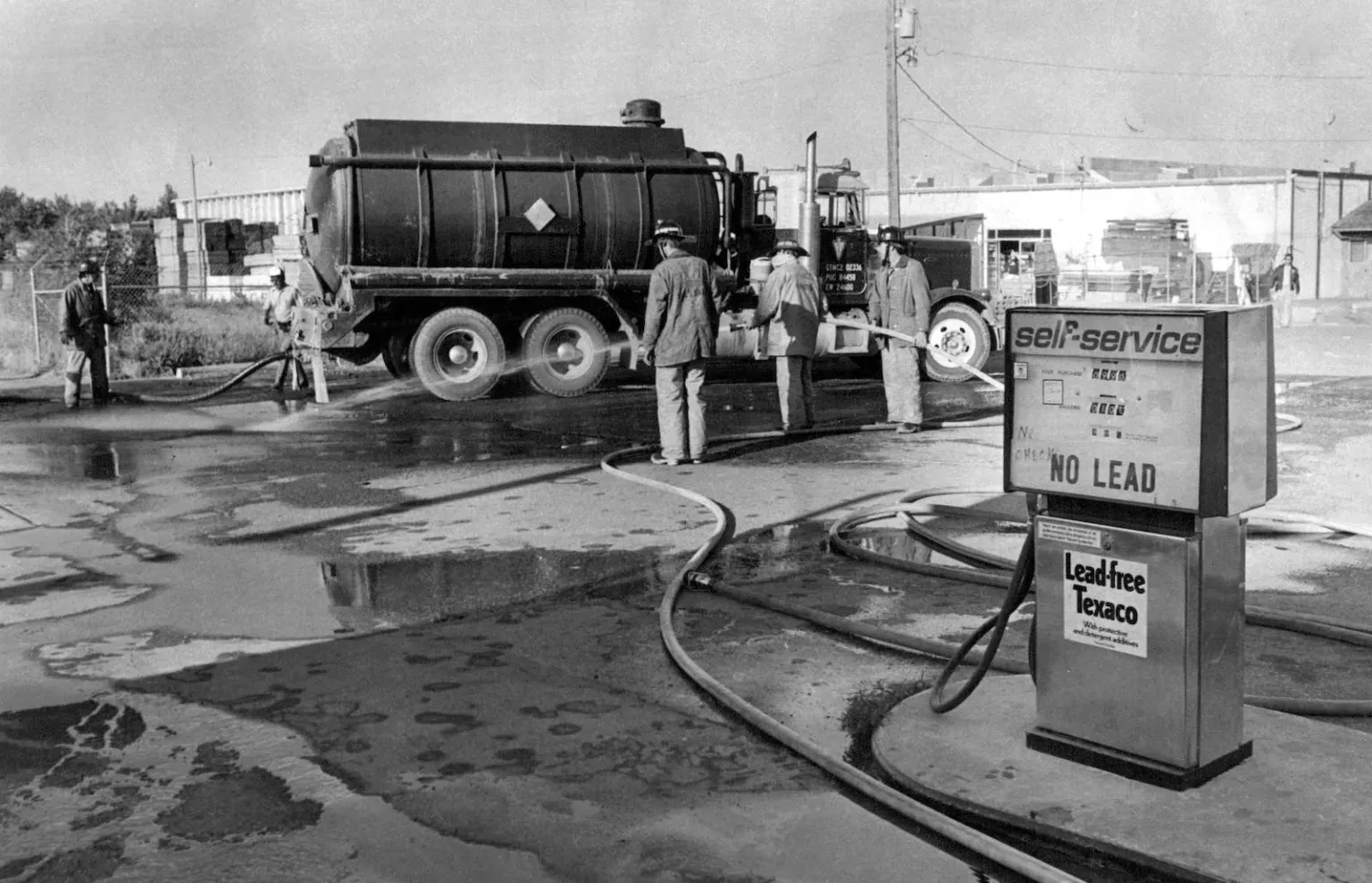
Glen Martin // The Denver Post via Getty Images via Grist
Selling gas stations
Firefighters spray liquid on a paved area near a large truck, with a gas pump in the foreground.
Another tactic was to sell stations — along with the liability for underground tanks — to new owners. The purchase and sale agreements for gas stations often contained a clause that indemnified the oil company for all harm caused by a leak, regardless of whether they were at fault, leaving the new owner responsible for the costs. An undated contract from Texaco, for instance, spells out that the purchaser would agree “to maintain all storage facilities” to prevent spills and “indemnify Seller for all claims, fines and expenses relating thereto.”
“I have talked to several gas station owners that have purchased gas stations from Big Oil,” said Ryan Bixby, the managing principal at the environmental consulting firm SoundEarth, who oversees cleanups in Washington state. “I think that some of the property owners really didn’t understand what they were getting into when they released that liability.”
Oil companies knew that gasoline posed a major health threat. In Rockaway, New Jersey, in 1980, a Shell scientist found that seven plumes were leaking from underground storage tanks, contaminating the groundwater with gasoline and methyl tertiary-butyl ether, or MTBE — a common gasoline additive that posed health risks and was particularly difficult to clean up. At Shell, an internal joke circulated that MTBE stood for “Most Things Biodegrade Easier”; later iterations of the acronym included entries like “Menace Threatening Our Bountiful Environment” and “Major Threat to Better Earnings.” In 1981, Arco noted in a memo that tanks were polluting the U.S. water supply with toxic chemicals such as benzene.
Leaking tanks went from a source of private hand-wringing to a public scandal in 1983, the year the 60 Minutes segment ran. The New York Times reported that millions of gallons of gasoline were seeping from storage tanks each year. Congress soon moved to protect groundwater supplies. Within a year, it had formed a national underground tank program and directed the EPA to develop a regulatory system to prevent and detect leaks and clean up tanks.
By 1985, the industry’s concern over regulations and liability had reached a fever pitch. National Petroleum News reported that “the day of reckoning” was nearly at hand, with tank leak liability giving “equipment distributors and oil marketers the cold sweats.”
That year, California created its own underground tank regulations, sending the oil industry into shock. In response, the oil company Unocal sent California dealers who were leasing its stations special legal agreements asking them to pay for inspection costs. “[Major oil companies] could also try to make lessees pay for repairs, registration fees and damages associated with leaks,” U.S. Oil Week reported, noting that Chevron was already pushing maintenance and insurance costs for leak-prone tanks onto its independent dealers.
Another response to impending regulations was to lobby allies in Congress. Representative Billy Tauzin, a Democrat from Louisiana with heavy campaign funding from oil companies, proposed limiting liability for the owners and operators of leaking tanks to $3 million. Critics labeled the proposed bill the “Exxon Relief Act.” Tauzin also tried to codify a loophole allowing oil companies to be absolved of financial responsibility for leaks simply by selling off tanks to gas station owners. But that failed when Congress took another step and passed an amendment to the Resource Conservation and Recovery Act in 1986, which held that no owner or operator of an underground storage tank could transfer that liability to someone else.
Regardless, gas station owners were facing another financial problem. Private insurers, being in the business of making money instead of losing it, began dropping out of their pollution liability contracts or rewriting them to exclude coverage for tanks in 1986. For some insurance companies, it was already too late — some went bankrupt from the soaring costs of covering pollution from gas stations, said Alexandra Kleeman, an attorney in Seattle who helps people buy and sell contaminated properties.
That left gas station owners in a tight spot. “The insurance companies seem to be conspiring to avoid the risk entirely by all dropping the pollution coverages at the same time,” read a newsletter from the Southern California Service Station Association in 1985. The association argued that small gas station owners had been left in a “catch-22,” forced to provide financial responsibility for tanks with “no means of doing so.” The situation led states to set up programs, such as Washington’s Pollution Liability Insurance Agency, to help gas station owners meet the financial requirement.
The EPA devised more fully fleshed out regulations for underground storage tanks in 1988, requiring that they have devices to prevent spills and corrosion on any metal parts. Gas station owners were given 10 years to upgrade their tanks or install ones that met the new standards. Mom-and-pop stations were not well-equipped to do so, and many were forced out of business after the 1999 deadline.
Hoping to make oil companies pay for groundwater pollution, local residents turned to litigation in the mid-1990s. A lawyer named Scott Summy was winning lawsuits against oil companies all around the country, arguing that oil companies knew that MTBE-laced gasoline would spread far and wide, contaminating drinking water supplies. Over the years, Summy won more than $1 billion in settlements for residents and public water providers.
With a fleet of upgraded and newly replaced tanks in the ground, and at least some justice served, underground storage tanks soon faded from national attention. Behind the scenes, however, some states quietly shifted the cleanup costs from polluters to taxpayers.
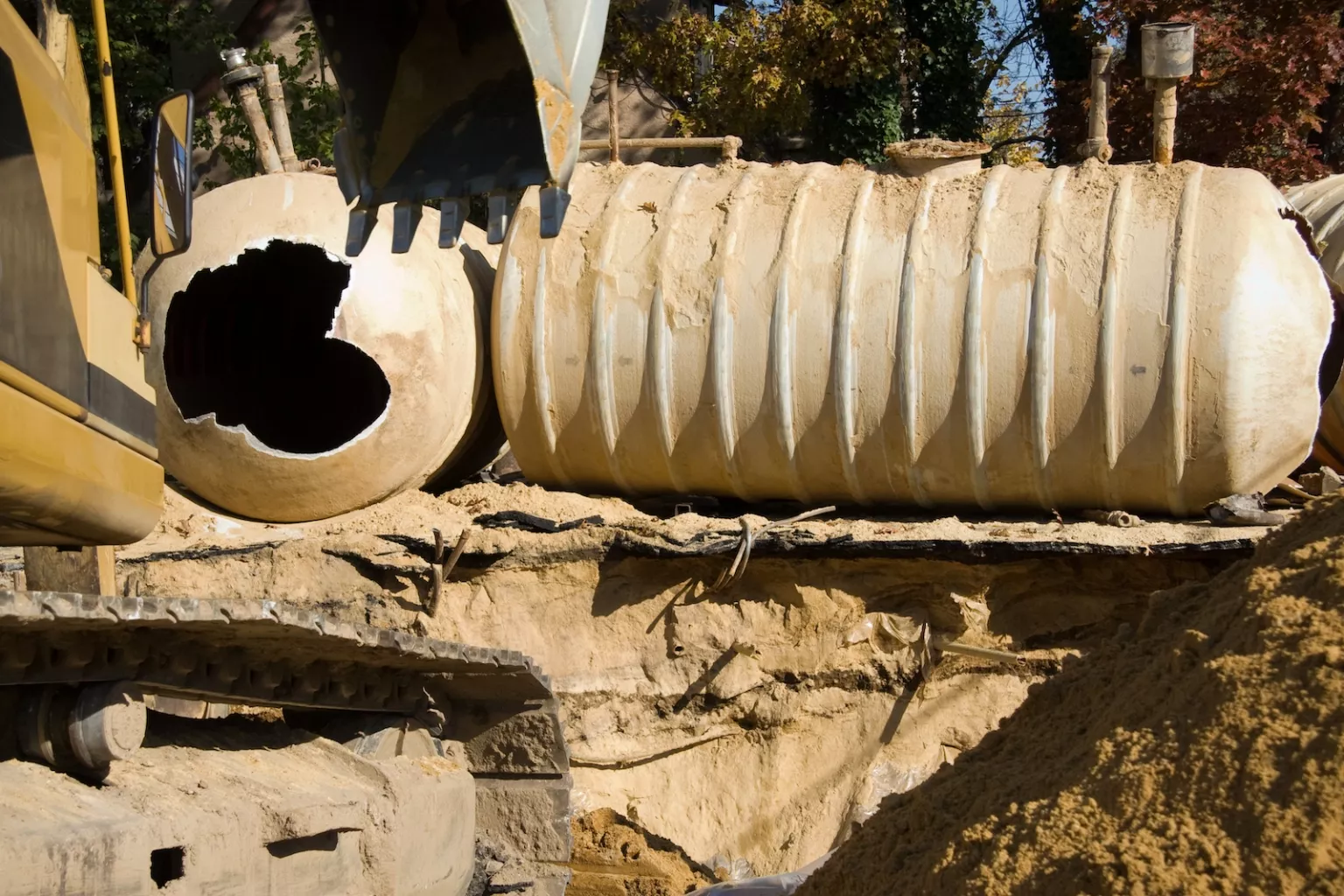
Nycshooter // Getty Images via Grist
Decontaminating gas stations
The claw of a backhoe digs out a large oblong structure from the ground.
In Indiana, for example, taxpayers spent more than $21 million decontaminating gas stations owned by former Vice President Mike Pence’s family after their company, Kiel Bros. Oil Co., went bankrupt in 2004. “Indiana has been especially amenable to using public money to pay for heavily contaminated soil to be excavated and for high-powered pumps to suck toxic liquid and vapor from the soil,” the Associated Press reported in 2018.
Arizona shifted the primary responsibility for cleanups from tank owners to taxpayers in 2004, an investigation by the Arizona Republic found. From 2011 to 2013, almost $45 million in taxpayer dollars was spent cleaning up leaks and spills from gas stations in the state because gas station owners were unable to pay the bill. At the time, more than one-third of gas station owners in the state had no financial coverage for their tanks, despite legal requirements.
The same story played out in Tennessee, too, according to reporting by the Tennessean. In 2016, the newspaper found that the state’s residents were footing 90 percent of the bill for cleanups. By 2021, the oil industry’s environmental fees that fed the state’s remediation fund had been eliminated entirely, while taxpayers were paying roughly $14 million each year through a tax on gasoline.
Anyone filling up their tank in the United States pays a 0.1 cent tax on each gallon of fuel that goes into the EPA’s trust fund for cleaning up leaking tanks, created in 1986 to pay for remediation when no viable owner could be found. More than $1.3 billion is sitting in the fund right now; last fiscal year, $67 million of it went toward remediating spills.
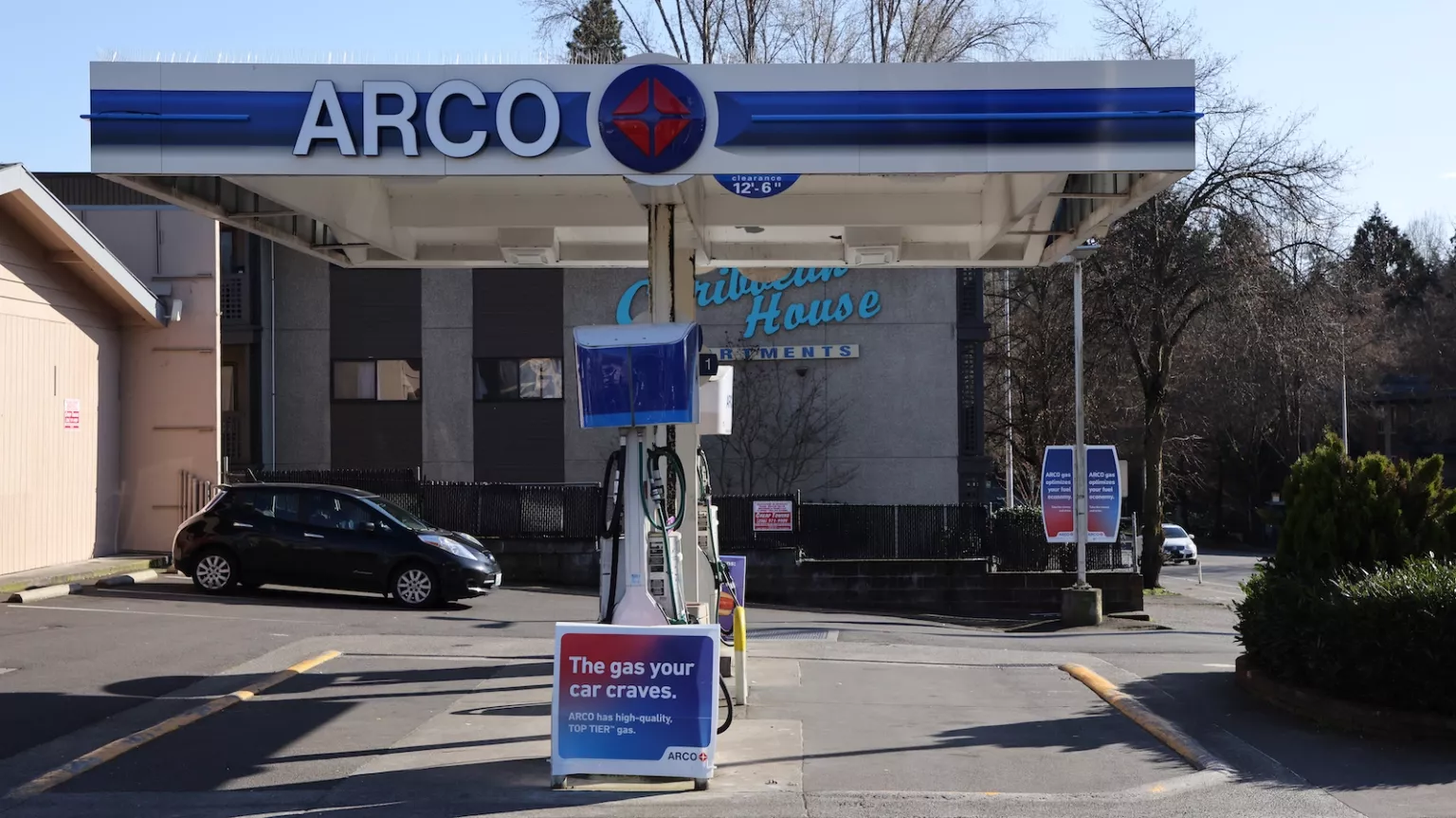
Jesse Nichols // Grist
Cleaning up leaks
A car is parked at a gas station.
Depending on who you’re talking to, the subject of underground storage tanks either elicits warnings of an impending disaster or praise as one of the country’s overlooked success stories.
Federal officials point to the hundreds of thousands of sites that have been remediated over the past 40 years. Last March, the EPA announced that it had reached the “significant milestone” of cleaning up more than 500,000 underground storage tank leaks.
The federal regulations put in place in the 1980s — such as banning bare steel tanks and requiring spill-protection equipment — have prevented countless disasters. New technology has emerged that helps detect problems sooner, with some detection systems able to find a leak by monitoring vapor, said Bixby of SoundEarth. That’s a more reliable way than the old “dipstick” method in which a worker manually dips a long pole into a tank to measure fuel levels, a practice that can eventually wear a hole in the bottom of the tank. Newer tanks also come with two walls and monitors that can detect when petroleum slips through the first wall of defense.
In Washington state, the Department of Ecology is finding fewer leaks. Back in 1990, it discovered 900 leaks a year; since 2016, the number has hovered around 30.
Brand-new tanks are fairly reliable when maintained and monitored correctly, experts told Grist — but these aren’t the ones environmental advocates are worried about. The aging tanks installed at the beginning of the 1990s were “still pretty rudimentary,” Bixby said. Many of these older systems, especially the sumps, weren’t designed to handle the corrosive mix of gasoline and ethanol sold in the United States. On top of that, only 57 percent of underground storage tanks in the country meet all federal requirements to prevent and detect leaks. In Washington state, just over half are in compliance with federal rules, according to the most recent EPA data from this spring. That means that at least 600 fail to meet safety standards.
“Failing to meet regulatory requirements increases the risk of a release, and/or reduces the chance that a release will be quickly discovered,” a spokesperson for the EPA said in a statement to Grist. States have a variety of tools to enforce the requirements, including fines and the ability to prevent gas stations from having more fuel delivered, the EPA said. But the fact that such a large share of gas station owners aren’t following the rules suggests that states are wary of making such moves.
Kleeman, the environmental attorney in Seattle, thought that one reason Washington state wasn’t cracking down was because it had other environmental priorities, such as climate change. “We do have a crazy number of impacted sites for being so green, but I wouldn’t say that abandoned gas stations or contaminated gas station sites are really that big of a concern,” she said. “On the scale of things that are probably keeping Governor [Jay] Inslee up at night, it’s not, you know, the big issue.”
Dangerous spills are still turning up across the country. In Monmouth, Oregon, a small town outside the capital of Salem, a 76 gas station spilled 14,000 gallons of gasoline into nearby groundwater in April 2021. The leak, discovered when workers at a sewage treatment plant a mile away noticed the scent of gasoline, was caused by a line failure at the top of an underground storage tank. “I’m not exaggerating when I say that if somebody had lit a match at the wrong time, people would have died,” said a state official who requested anonymity because they were not authorized to speak to the press. “The vapor from that escaped fuel was definitely above the ignitability threshold.”
It’s hardly an isolated anecdote. In Provo, Utah, 55,000 gallons of gasoline escaped from a storage tank into the soil and groundwater in March 2018; the state’s environmental department called the incident “catastrophic.” In Lily Lake, Illinois, a rural town outside Chicago, a Shell gas station under construction spilled nearly 8,000 gallons of gasoline after heavy rain flooded tanks last April, sending petroleum into a nearby wetland. And in November last year, a gas station in Bloomington, Indiana, spilled several thousand gallons of fuel due to a leak in the storage tank or piping.
Washington state has the sixth-biggest backlog of leaking underground storage tanks, behind Florida, Michigan, New Jersey, Illinois, and Pennsylvania, according to the EPA. Long waiting lists aren’t necessarily signs of indifference. They can be a result of stringent groundwater standards or geography. West of the Cascade mountains in Washington, high groundwater levels can cause leaked gasoline to spread further.
Barry Rogowski, the program manager for the Washington Department of Ecology’s toxic cleanup program, said that underground storage tanks are one of his agency’s priorities. Over 4,000 sites have been cleared by the state, with some 2,500 to go. A lot of the remaining contamination is hard to reach — with contaminated water sitting under, say, a railroad track or major roadway — and requires additional resources, Rogowski said. The Department of Ecology recently hired six staffers to help with tasks like sampling and site assessments to chip away at the backlog.
The reluctance of private insurers to cover aging tanks left Washington looking for new options. Under a longstanding program, private insurers provide $75,000 of the total $1 million of insurance for the tanks, with the state backing the rest. But if insurance companies decided to back out of the reinsurance program entirely, as some officials feared they might, the Department of Ecology would have to go around shutting down gas stations that no longer complied with the law, according to Garcia of the state’s Pollution Liability Insurance Agency.
So this year, Garcia’s agency worked with state legislators to pass a bill, HB1175, implementing a new system. For each gas station that enters the new program, the state will cover $1 million for old leaks and $2 million for future ones. The funding comes from a small tax on oil companies when selling their products in the state — which is increasing from 0.15 percent to 0.3 percent — along with premiums from gas station owners. Garcia said that the new approach gives the state more control over gas station cleanups by taking out “the insurance middleman.” Governor Inslee signed the law in April.
Critics of the law, such as Metz — the anti-gasoline advocate — called it a “bailout” of a dying industry. He sees gas stations as a link in a long supply chain that originates in the oil fields and ends with carbon pollution spewing from tailpipes. The transportation system has become the largest source of greenhouse gas emissions in the United States, much of which comes from vehicles pumped full of gasoline and diesel at the pump.
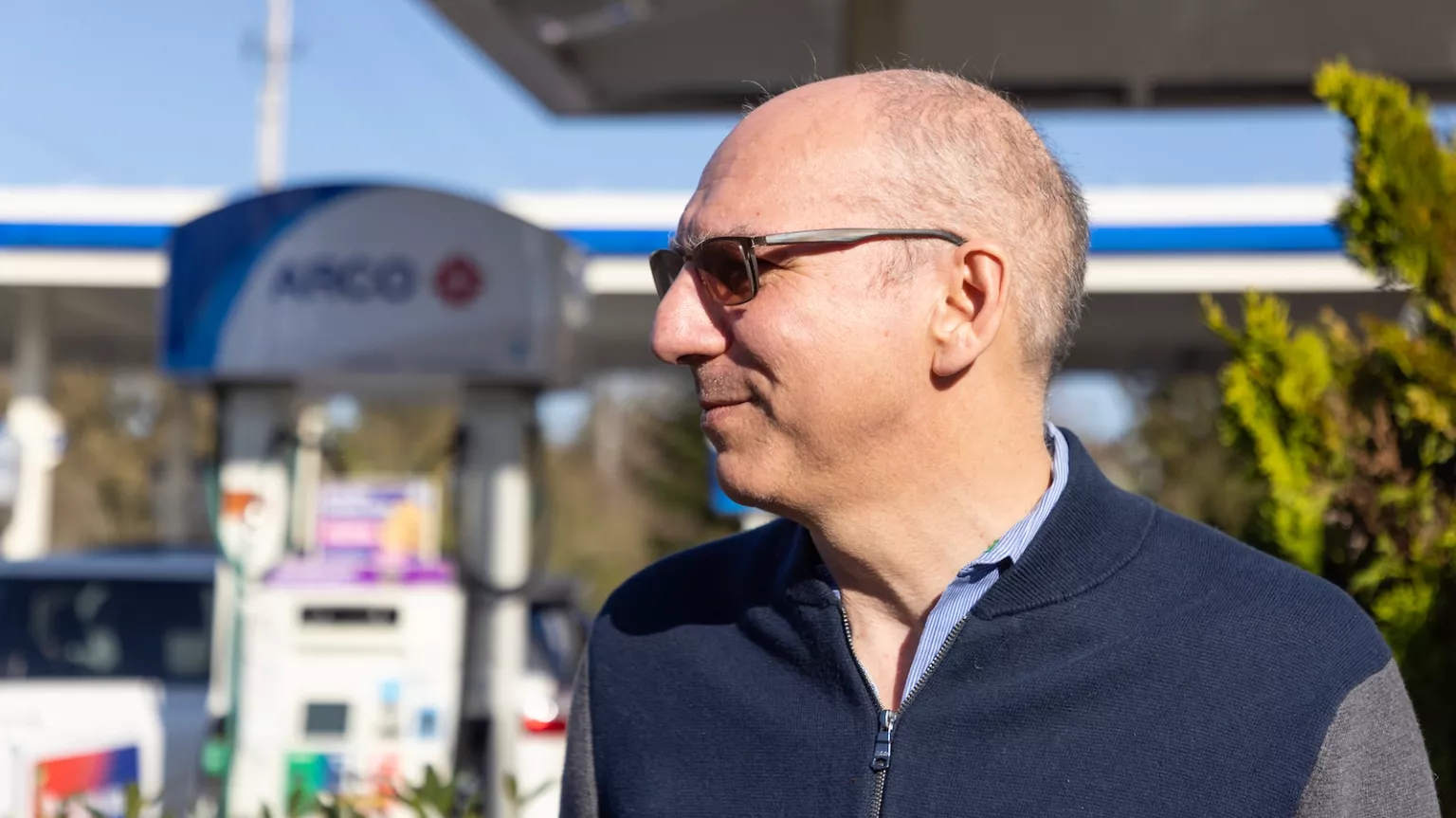
Portrait of Coltura founder Matthew Metz by Jesse Nichols // Grist
Prioritizing prevention
A man wearing sunglasses stands in front of a gas pump.
Some environmental advocates are skeptical that the new policy will cover all the costs. “If we have 2,000 tanks that need to be cleaned up, that’s basically a billion-dollar liability,” said Clif Swiggett, who leads policy analysis at Carbon Washington, a climate policy nonprofit. “So that’s a huge amount of costs that’s about to come over the horizon. … These gas stations are going to go out of business, and in a big wave, if we successfully electrify transportation.”
One of Metz’s complaints with the legislation is that it doesn’t prioritize prevention. When asked which states had done a good job preventing spills, the EPA pointed to Colorado, which has spent the past several years using its petroleum industry-funded cleanup money not just to address leaks, but to stop them from happening in the first place. Mahesh Albuquerque, the director of Colorado’s Division of Oil and Public Safety, said the state rewards gas station owners for removing their tanks by offering $1 for every gallon removed, up to $30,000. The thinking is that better equipment (and fewer tanks) could save the state money in the long run by cutting down on remediation costs.
Colorado has spent $4.3 million on these kinds of incentives over the last two decades, and its tank-removal reimbursement program has helped take nearly 500 old tanks out of the ground, Albuquerque said. The average age of an underground storage tank in Colorado was roughly 27 years when the program started in 2019, in line with the national average calculated by the EPA at the time; today, Colorado’s average is down to about 25 years. (The EPA does not maintain current data on the average age of tanks, a spokesperson told Grist.)
“The benefit has been huge for our state, where it’s incentivized owners to actually be a little more proactive,” Albuquerque said. “The focus needs to be on prevention rather than cleanup.”
The approach has resulted in more gas stations adhering to federal standards. In Colorado, 93 percent of gas stations are in compliance with the EPA’s rules for preventing leaks, the second-highest compliance among states after Wyoming. Gas station owners who fail to follow these standards face consequences: In the event of a leak, owners are eligible for $2 million in reimbursement for cleanup costs from the state — but how much they get reimbursed depends on their track record of meeting the guidelines. The state might cover only 75 percent of the costs for an owner who violated the rules, for example, or deny all reimbursements for particularly egregious violations, Albuquerque said.
Even with these measures in place, new leaks continue to be discovered in Colorado, running the state about $37 million in cleanup costs every year.
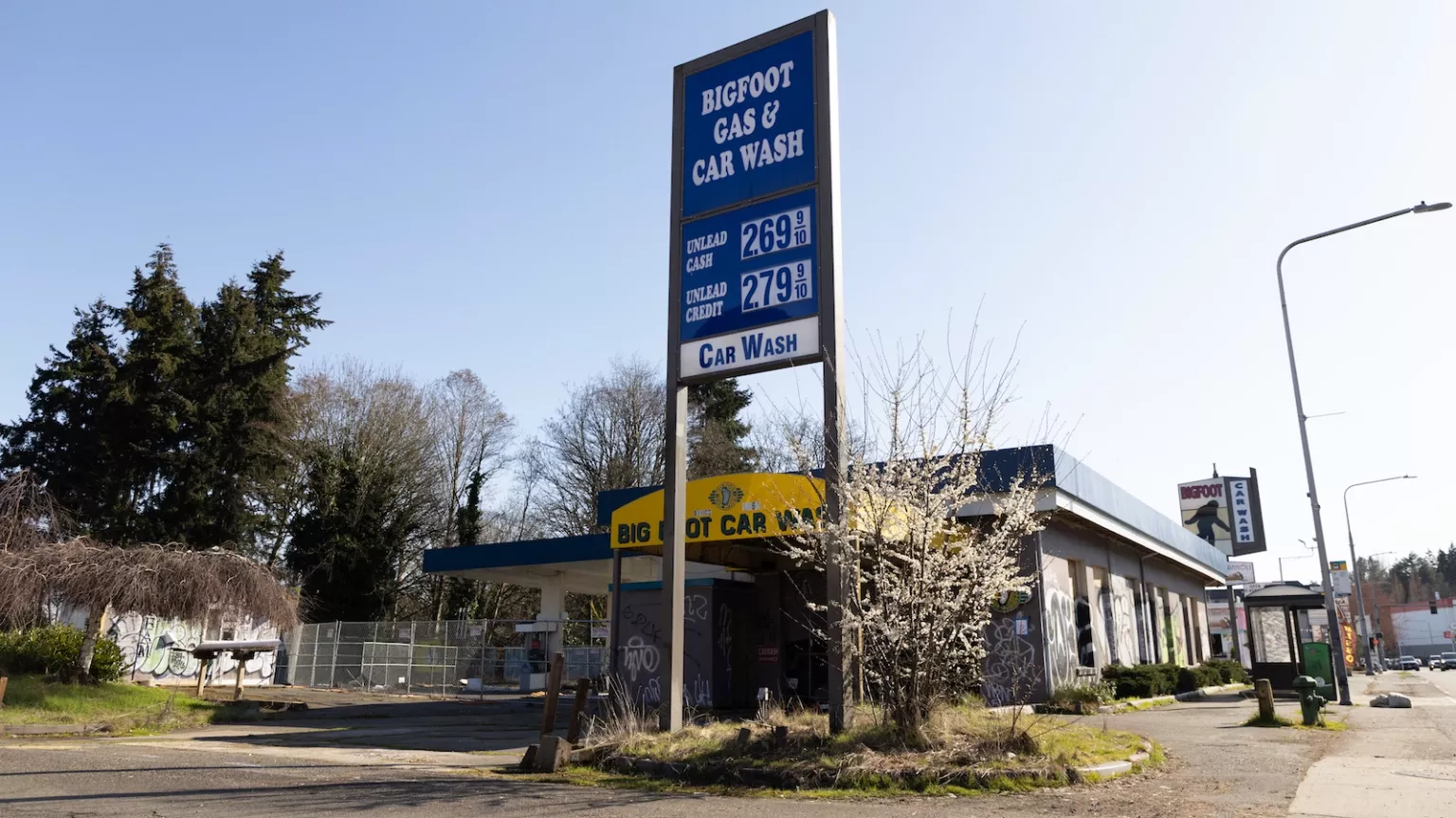
Jesse Nichols // Grist
Abandoning gas stations
A sign advertises the Bigfoot gas station and car wash.
Electric vehicles could well be the biggest shift in American transportation since cars replaced horses. But what happens to gas stations — and the tanks beneath them — when hardly anyone needs gasoline anymore?
Looking at an abandoned gas station today gives you a preview of what might be coming. At the Bigfoot gas station in North Seattle, unleaded gas is priced at $2.69 — one indication it’s been closed for a few years, along with the graffiti covering the building. When I visited the site in March, a biker zooming by craned his neck to call out, “Check out that sinkhole!” A chain-link fence guarded a cavernous hole in the ground by the old gas pumps, concrete breaking off around its edges. At the tiny, pink cannoli stand next door, a barista waited at the window, looking on at the forlorn facility.
The common-sense solution for the future of gas stations is to turn them into EV charging stations. But the convenience store model might not translate. Most people charge their vehicles at home. Road-trippers require fast-charging stations along the highway. Public parking lots are a good place for chargers, but running into a convenience store to buy peanut M&Ms doesn’t take more than five minutes or so, not long enough to get much juice from even the fastest chargers. People might prefer to charge up while running longer errands, like grocery shopping. Walmart, for example, recently announced it would install thousands of chargers at stores around the country.
In theory, a gas station lot could turn into anything. But developers are reluctant to take on contaminated lots. The process of excavation might unearth complications, such as an old tank that no one realized was there, or contamination that went undetected in the initial inspection process. “You often don’t find these impacts until much, much later,” Bixby said.
Developers hesitate to get involved with a contaminated property, but if they do, they can push the cleanup process forward. “It’s rare that a landowner just says, ‘Oh, well, I’m aware of the contamination, it’s on my property, it’s my responsibility, so I will clean it up,'” Bixby said. “It’s more common that that cleanup happens when somebody is interested in buying the property and a lender says, ‘Well, that’s great, but I’m not going to loan you any money on it until your property is clean.'”
Bixby recently finished cleaning up a property in the Rainier Valley in South Seattle that had been contaminated for more than a decade. Property transactions kept falling through until a developer came along who wanted to put in below-grade parking. That made it easier to sell, because it cut down on the costs of hauling in new soil: A contaminated site generally requires digging up the dirt, trucking away the contaminated soil, and backfilling the giant hole.
In that case, the big oil company that was responsible for the contamination settled a case for $1.8 million, Bixby said. The total cost of the cleanup was even higher. It’s common for oil companies to settle cases long before they get to court. That’s because if the case goes to trial, the polluter may not only have to cover the cleanup costs, but also the plaintiff’s attorney fees, which can be almost as high, Bixby said.
Some abandoned gas stations have ended up with a more creative future, but even those come with headaches. A group of artists recently converted an abandoned gas station in Seattle’s Georgetown neighborhood, across from Boeing Field, into a community center and art museum called Mini Mart City Park. It took 15 years of environmental studies and soil cleanup, with the project totaling close to $2.3 million.
Given the toxic legacy of gas stations, some communities have begun pushing back against their development. Two years ago, Petaluma, California, became the first town in the country to ban new gas stations, following its declaration of a “climate emergency” in 2019. In March, Sonoma County prohibited their construction. Even famously car-centric Los Angeles has considered a similar ban.
For Beth Doglio, one of the Democratic state representatives who introduced HB1175, seeing new gas stations has become a source of frustration. “The energy right now to fuel our vehicles is this totally toxic, gross shit that’s underground,” Doglio said. Getting rid of the storage tank problem is a benefit of going electric that hardly anyone thinks about, she said.
“It’s not going to cost a fortune, $1 million, to fix a charging station. It’s kind of exciting. That, to me, was like, ‘Oh, wow, here’s yet another benefit of the clean energy transition.'”
This story was co-published with Crosscut.
This story was produced by Grist and reviewed and distributed by Stacker Media.

